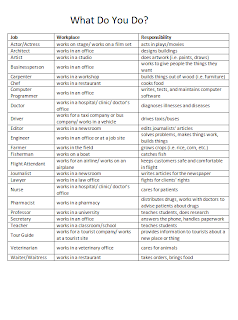 Professions Worksheet:
Professions Worksheet:
Professions + Daily Routines Activity:

This class seems to have been an appropriate and engaging way to wrap up Unit 2. In hindsight, I regret not taking a picture of the blackboard after the professions activity. The board was divided into four sections: blue team, red team, yellow team, and green team. At the bottom of each section, students listed their professions. At the top, I recorded points and wrote grammar corrections. In my mind, the blackboard represents the dynamic and multi-faceted nature of the game.
The game progressed as follows: First, students chose their professions. There could only be one of each profession on a team. Second, students filled out the front of the worksheet, answering questions about their daily routines. Third, students interviewed people from the other teams, using the questions on the front of the worksheet and filling in the chart on the back. Each student talked to five people so teams had to strategize so that as a whole they had information from everyone on the other teams. Explaining the game portion of the activity before the interviews helped because students understood why they were talking to each other and how they should work with members of the other teams. For example, it was advantageous, albeit time-consuming, to follow the directions and communicate verbally rather than exchange papers to record answers because this provided room for error in which the other team might mishear a student's response.
During the game portion of the activity, I asked a question about each team in turn. For example, (standing in front of the yellow team's list of professions), "What time does the pharmacist go to work in the morning?" The first person to stand from the red, green, or blue team could answer. I was assured an assortment of volunteers since each person talked to five different people. At the beginning, I judged on basic content, but as the game progressed, I made the rules more difficult by discounting answers with grammar mistakes. By requiring students to use correct grammar, those who answered were more likely to consult with their team, and those not answering were more likely to listen aptly and wave their arms in the air and yell if they heard a mistake. Students were enthused to the point that I had to make a serious announcement about sportsmanship, which was well-received. All in all, the activity was a wonderful way to facilitate partner conversation and critical thinking, review professions and daily routines, engage in guided practice of grammar and pronunciation, and get excited about using English.
Lastly, a self-evaluation...

No comments:
Post a Comment